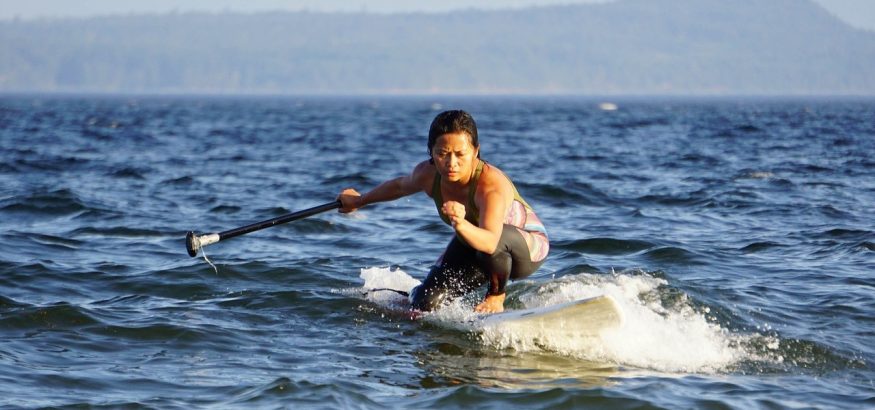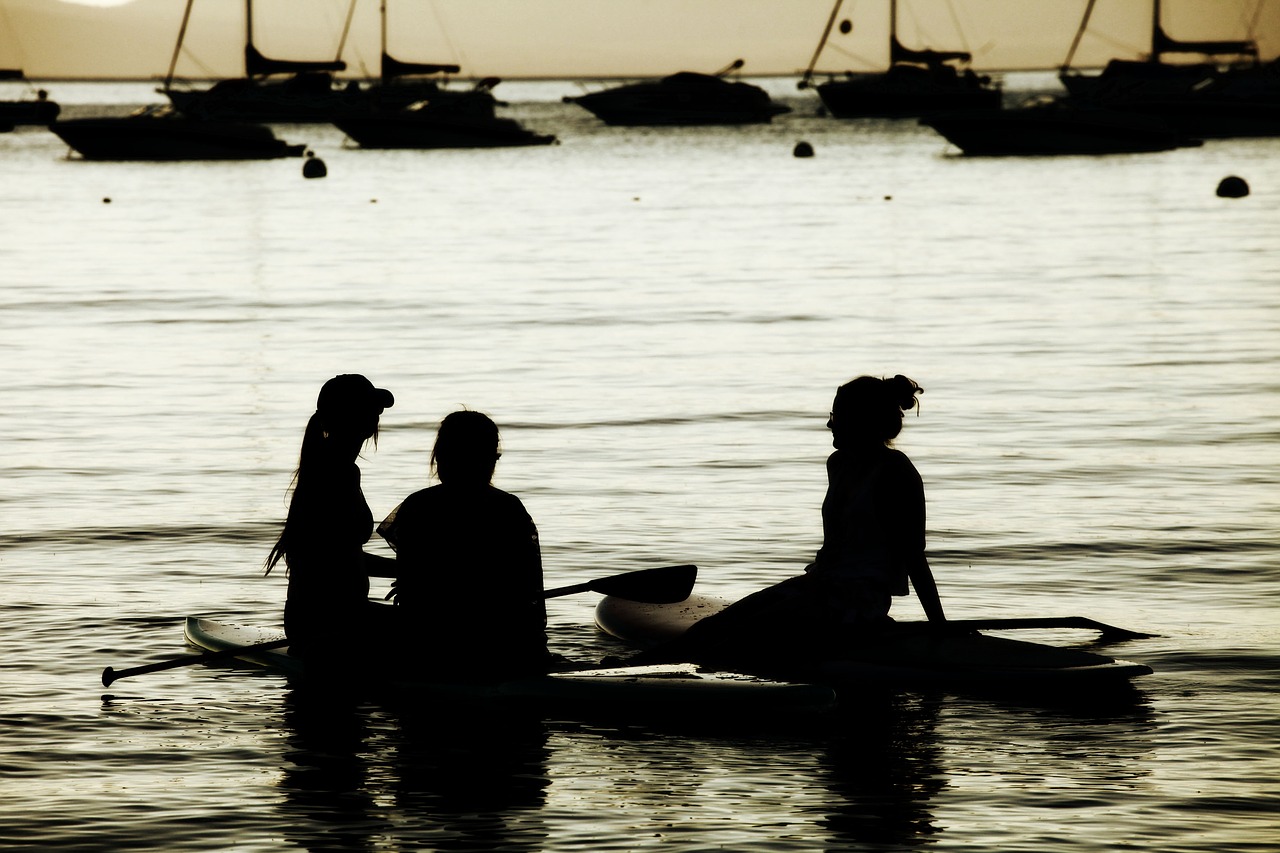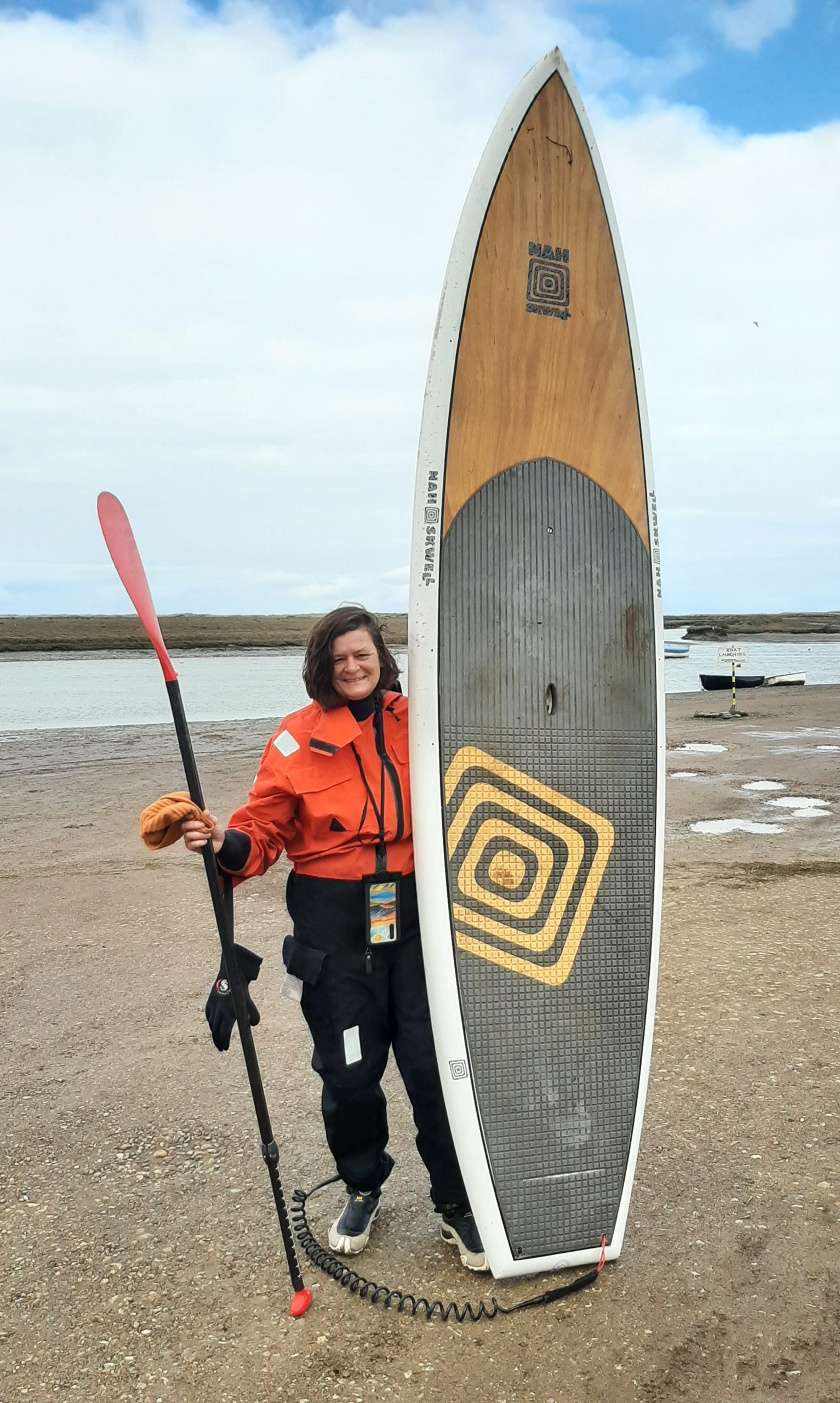Stand Up for Yourself
I make no excuses for writing about Stand Up Paddle Boarding again… but this time I am going to be uncompromising and brutal. I am parking the man of science and gentle informed persuasion, and re-inventing myself as a fundamentalist exercise warrior. My weapons are inflatable, and I am aiming them at everyone who will listen.
Before we all became properly epidemic savvy by necessity, the word epidemic was used a lot within public health media. We were constantly informed that there was an epidemic of this, or an epidemic of that, within our societies. It would be obesity, or cardiac disease, or diabetes, or back pain … so not actually your bona fide epidemics, but the word had some punch. I always felt that there was one missing. An example that didn’t seem to warrant the pseudo epidemic status, but for me was just as widespread, and just as damaging to our overall health as all the others. You won’t want to hear this but many of you may be sufferers… that’s the new brutal me.
For some, this epidemic starts in our early years.
For most it increases pace in our fourth decade and beyond.
It cannot be treated by medicine.
But it can be a contributing factor to several debilitating and painful medical conditions.
It can go un-noticed for decades.
The outcome of not attending to it costs our health systems millions, but not attending to it is almost the norm.
Battered and quivering I hear you ask “what is it”?
Well… it’s WEAKNESS.
There. I have said it. I warned you that there was going to be no compromise. But is using the word more damaging than it’s physical consequences? Does it read more like an accusation and not an observation? Is being told you are weak worse than actually being weak? Do you extend the association of the word with weakness of character, or weakness of mind?
I can’t keep up the pretence. Shouty fundamentalism isn’t really for me, and I find the “weakness” word unsympathetic and of little use within the public health arena. I prefer it’s definition found within any language dictionary, which is always “lack of strength”. Or the slightly more subtle definition found within a medical dictionary, which is usually “loss of strength”. They both work:
“Lack of strength”: you have got some strength, but it’s not enough.
“Loss of strength”: you may have been strong, but you are less so now.
But you still have strength, and that’s the one thing you can use to build more strength. You think I lifted that straight from “Five Weeks to a New You”, by Dr Clint Afterburner (don’t Google him, he doesn’t exist). Nope… the statement is real life, evidence based fundamentalism. Strength training is underpinned by a ridiculously simple principle. You find an achievable and appropriate movement that you can perform with your current strength levels… and you load it further. Be it with increased resistance, or time, or repetition, or mechanics, or a combination. In fact, where possible it could be that you “overload” it, in that you push towards the upper end of it’s current capability. The muscles, tendons, nerves, bones and ligaments get a right spanking, which upsets them, and frightens them into thinking you might do that again (I know bones don’t think). Insult them with enough overload and they will have to recover, rebuild and ultimately re-engineer themselves to become a bit more resilient to this insult in the future. Basically, be rude to your muscles and they will become all the more stronger for it. If you keep doing it consistently, and think up new and varied insults, then the whole of you becomes stronger. But you cannot hold back… keep using the strong language of overload.
However, who needs to be strong? No seriously… where is the need? We are surrounded by a social and environmental construct that no longer requires us to be strong. Cars, elevators, doorstep food delivery, phones, digital living, healthcare, welfare, Netflix, Amazon, drive through, convenience, accessible, attainable, instant… unchallenging. You own a body that has become conditioned to assistance and not resistance. This is one of the biggest and most pervasive of public health ironies. Back in dictionary corner “assistance” is defined as “the action of helping”. Well it doesn’t. Deprive the body of physical resistance and load, and it deteriorates because it has no need to recover, re-build and re-engineer itself.
Back to identifying who needs to be strong, it is quite clear that we all do. However studies, reports, initiatives and programmes identify certain sections and groups within our society that are at risk of significant strength loss. Sedentary occupation men over 50, post pubescent girls, Muslim community women, young adult gaming generation males, inner city over 70’s… it’s quite a long list. But there is a huge and broad group that public health experts agree are most vulnerable to slipping into an insidious strength deficit. That is women from around 40 years old to 60 years old. According to The Office for National Statistics there are around 9 million UK women in this group. The clinical and social reasoning behind identifying this group as a concern is well established and much discussed. They are somewhat clumsily termed the decades of “change” for women in terms of physiology, physical structure and family and social “roles” etc. And of course getting older. I don’t want to portray this as some sort of bio-psycho-social meltdown, because it most certainly isn’t. Neither is it a certainty that women have to lose strength in these decades. But the rules still apply… you have to do some strength or you’ll lose your strength. The obvious question that arises is how many women in these decades are consistently challenging the upper reaches of their strength capacity? (And the 9 million of you who are thinking “how many men are as well”… I hear you, and you are right.)
It’s list time: Osteopenia (loss of bone density), sarcopenia (loss of muscle mass), tendinopathy, bursitis, capsulitis, accelerated age related joint changes. These are all common within 40 – 60 year old women. Take shoulder rotator cuff aggravation. It doesn’t get a lot of press compared to osteoporosis or hip OA, but it is significantly common in women of this age group. In China they have a name for it… “The 50 Year Old Shoulder”. Or take gluteal tendinopathy, this is also high up on the women’s hit parade of aches that become proper pains. Current thinking on the causes of the conditions on the list is varied, but almost all are underpinned by a lack of strength, and can be improved, or potentially avoided, with an increase in strength.
Another list: withdrawal from physical activities, poor awareness of physical capability, self-conscious avoidance behaviour, reluctance to taking on new physical challenges, feeling physically disadvantaged, fear, avoidance, missing out. It’s not an inspiring list to read, and you have probably guessed that these are behavioural traits associated with 40 – 60 year old women who are struggling to engage, or re-engage, with demanding physical activity. There are many factors that contribute to this, with one of them being a genuine, or perceived, lack of strength… or perhaps another phrase would be lack of “strength confidence”.
There is good news though. Strength is freely available to all. The only essential cost is effort… that is non-negotiable. The question should never be “should I get stronger?” It should be “how am I going to get stronger?” Where are you going to find your overload? How can I enjoy my efforts? What suits me, in this case as a 40 – 60 year old woman. It could be that finding a gym with an experienced weight training coach, and learning to lift, and then lifting heavy and regularly, is exactly your thing. And trust me, if it is, you will get strong. But it isn’t for everyone, and in fact, it could really be for just a few. Strength does not have to be delivered in just one way. It is all around us at village hall classes, on Youtube, in the garden, on a bike, at netball training, building a shed. But sometimes it is convenient to package it up within a new challenge, an inspiring hobby, an “activity” choice that levers strength training into your lifestyle along with new achievements, friends and the F word (fun). Say something around 10 feet long, 30 inches wide, pointy at one end, and capable of taking you to places you have never been before. A paddle board.
It’s not an idea, it’s a proper thing. The uptake of paddle boarding in women has been astounding. Sales figures, not science, tells us this. I work closely with Andy Holland at www.supslife.com on my paddle board projects, and he has calculated that over 50% of his sales are now to women. At a 2021 market leading manufacturers sales team meeting we heard that the largest proportion of board sales was currently to women, and of course efforts will be made to develop this market further. I could go into the social, cultural, health reasoning etc behind this, but I am focused on strength right now. I want to convince you that the paddle board is the ultimate strength vehicle.
Paddle boarding has a bit of a “Zen” reputation. Gliding along backwaters, quietly re-connecting with nature, and yourself. Breaking out into some spontaneous yoga. Camping on deserted islands. Unfeasibly small bikinis and male celebrity thong disasters. Finding the mythical lost creek. Tickling dolphins. Well, there certainly can be a bit of that, but the reality is a bit sweatier, and often comes with bruises. Let me tell you the things I like most about paddle boarding.
You have to carry them, be that inflatable or hard board. Rucksack style, drag, underarm… you have to heave them about and load and unload. You have to get to and from the water. This is an opportunity.
You have to pump them up, or lift them on and off a roof-rack. Wash them down and wrestle them back into the shed. More opportunities to express your strength.
You have to paddle them. Pick your distance… go long now and then. The wind will get up. You will miss the tide. You have to come back upstream from downstream. You will have to paddle harder. Sometimes very hard. This is an opportunity for some proper strength endurance training. Embrace the soreness the next day, it’s just your body re-engineering itself to be stronger.
On other occasions you can choose your efforts. Go hard one day, but go easy if you want to. In fact you can vary your efforts on each paddle. Take on a hard section, then ease off. Put in a few sprints, vary the intensity. Go out against the flow and recover on the way back. You can get strong on your own terms.
You can train with friends. Nothing is more motivating than a shared effort. Keeping up with a stronger paddler may be hard… but keep on keeping up, and after a few sessions they won’t be that much stronger.
Your “strength confidence” will build. The fact that you can do more will mean that you will want to do more. Compliance is high because any day on the water is better than being stuck in the hutch. It can be hard, and cold, and your body may complain, or the conditions may beat you… but the “post paddle high” will soon have you back on the water.
But the thing I like most about paddle boarding, particularly for women in this age group, is that the strength training is almost hidden within the whole activity. It’s part of the package whether you like it or not. If you go regularly you officially become a paddle boarder, there are no exams to take. Middle aged blokes love telling people that they are cyclists… tiresomely so. Hit back. Mention you prefer a wet suit to a skin suit, and then go at them hard with a 5 minute description of your new carbon fibre paddle. Pay back time.
I wasn’t sure how to wrap this one up until this weekend I was down at one of my local harbours and came across a friend of mine coming in from a morning paddle. It’s February and she was kitted up in full winter battle dress and looked fatigued but victorious, and inspirationally strong.
For more info on SUP health benefits from myself click: SUP Health Article
For my research reviews on SUP click: SUP Research
For a SUP strength workout click: SUP Strength Video




Comments are closed.